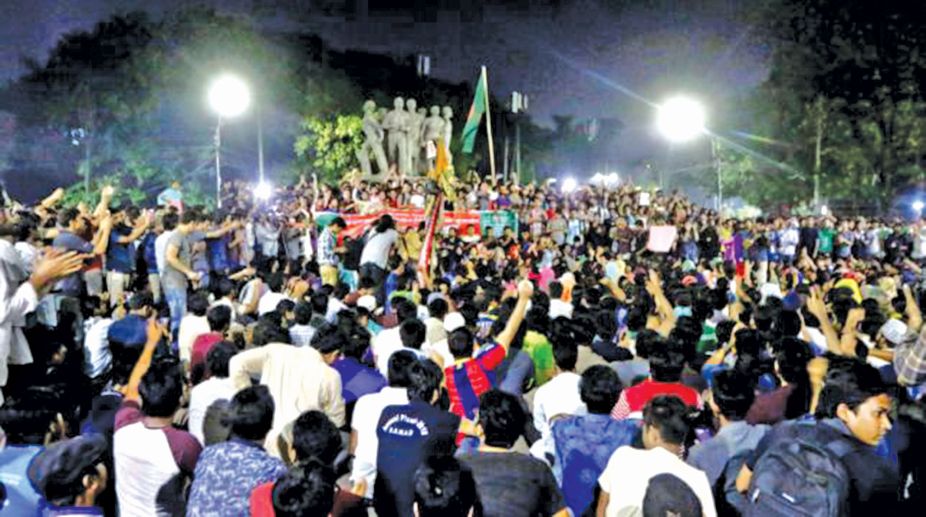Cong defeated ‘Bangladesh’ in semis, will rout ‘Pakistan’ in finals: Reddy
Reddy was addressing a meeting of the Congress social media team and took digs at both the BJP and the BRS.

Dhaka University campus
Bangladesh’s youth have done it again. The cause they stood for was fair and just; they remained resolute in their stand and united against all odds. For years, they waited for the revision of archaic provisions of public services recruitment procedure that privileged less competent ones over the meritorious.
Years passed by, governments changed, Public Service Commission leadership changed, recommendations of various committees and commissions that argued in favour of amendment fell on deaf ears, and finally, patience of the youth ran out.
Finding no other option, they took their legitimate demands to the streets. Gradually, the just, peaceful, non-violent cause began drawing attention of their peers. The latter found reason to join the protest; after all, it affected their future as well.
Advertisement
The collective voice became stronger and louder, their numbers swelled. That, in turn, drew the attention of the media. While a section of the media found reason to cover this non-partisan civic protest; another, loyal to the ruling quarters, smelled conspiracy of the “defeated forces” to disrupt the flow of development and their own brand of democracy.
The peaceful agitation became contagious. What essentially began as a movement of the students of Dhaka University, secured the support not only of students of various public universities but also of the private universities. The protest spilled over to other towns and cities setting off alarm bells in concerned quarters.
The protesters decided to gather at the Dhaka University campus for a day-long rally on April 8. Undaunted by threats and intimidation, they assembled at Shahbagh, the shrunken site to voice dissent in this mega city, and peacefully conveyed their message through the loudspeakers to the people.
Point by point they explained why they felt reform in the recruitment process of the public service system was necessary, how the system discriminated against the meritorious and how the country is adversely affected by the dominance of the non-deserving in the civil administration.
More importantly, they referred to the constitutional provision that explicitly stipulates that special measures could only be taken for those belonging to disadvantaged communities and physically challenged.
While they appreciated the background of district quota and freedom fighters’ quota in the immediate aftermath of the liberation war, they felt with the improved communication network and with aging of the generation of freedom fighters, those temporary measures should now be made redundant.
Quite justifiably they articulated the need for retention of quotas for disadvantaged communities and those physically challenged.
The students presented their case with reason and logic, invited their opponents to engage in open debate. They did not challenge the authorities; they had no reason to do so.
They wanted to engage with them. They knew well ultimately it was the state that had the power to bring about the change that they wanted. Protest was their last resort to secure the ears of those in power.
Unfortunately, in a polity where anything not explicitly approved by the state is considered to be an aberration, if not seditious, the actions of these young, active citizens were deemed to be anti-government.
The foot soldiers of the regime, the student wing of the ruling party, in various educational institutions found it incumbent to nip what they viewed as “deviation”; thus threats, intimidation and physical violence were meted out.
Despite the importance of the issue, the mainstream media that is generally in the lookout for new stories did not find value in the event and have largely shunned it.
As the day was drawing to a close without provocation, the security forces clamped down on the students with batons, water cannons, rubber bullets and teargas with the purported aim of clearing up the Shahbagh intersection.
It is the same group to whom, earlier in the day, as a gesture of goodwill, the students had offered flowers only to be refused. This highhanded approach further escalated the situation. Until the wee hours of the day, students held the streets and refused to budge.
Rumour of the death of a demonstrator added fuel to the fire. Taking advantage of the situation, unknown elements attacked the vice chancellor’s residence and caused immense harm. Time was not wasted to point fingers towards the agitated students which they steadfastly denied. “What gain would we have made by doing so?” they asked.
Acknowledging the gravity of the situation, the government extended olive branch to the students and promised to look into the matter, but then an over-enthusiastic veteran minister and onetime firebrand student leader accused the students of causing mayhem.
Justifying the quota system, she asked if the privilege accorded to the freedom fighters’ children should be sacrificed for the children of the “razakars” (collaborators)? This time this oft-used method of silencing dissenting voice backfired.
Students were enraged at the insult, called off the deal, demanded apology and also announced that nothing short of prime ministerial commitment will assuage them. Then came the prime ministerial intervention. The quota saga offers some important insights.
It reveals deep alienation of the ruling elite from people’s aspirations that leads to inertia in policy reforms. It also shows if opportunities to seek solution are made unavailable, mass civic movement becomes the last resort to realise people’s goals. It further informs that those committed to a cause cannot be deterred by insinuation, threat, intimidation and even violence.
A fresh chapter has unfolded in the history of student movement of Bangladesh. One hopes that in a polity that is so deeply divided along partisan lines, the new generation of youth, unfettered by mainstream party affiliation, will continue to espouse broader civil, political and social issues in similar stride to create a just society which is the dream of every Bangladeshi. That rainbow appears to be making itself visible in the horizon.
The Daily Star/ANN.
Advertisement